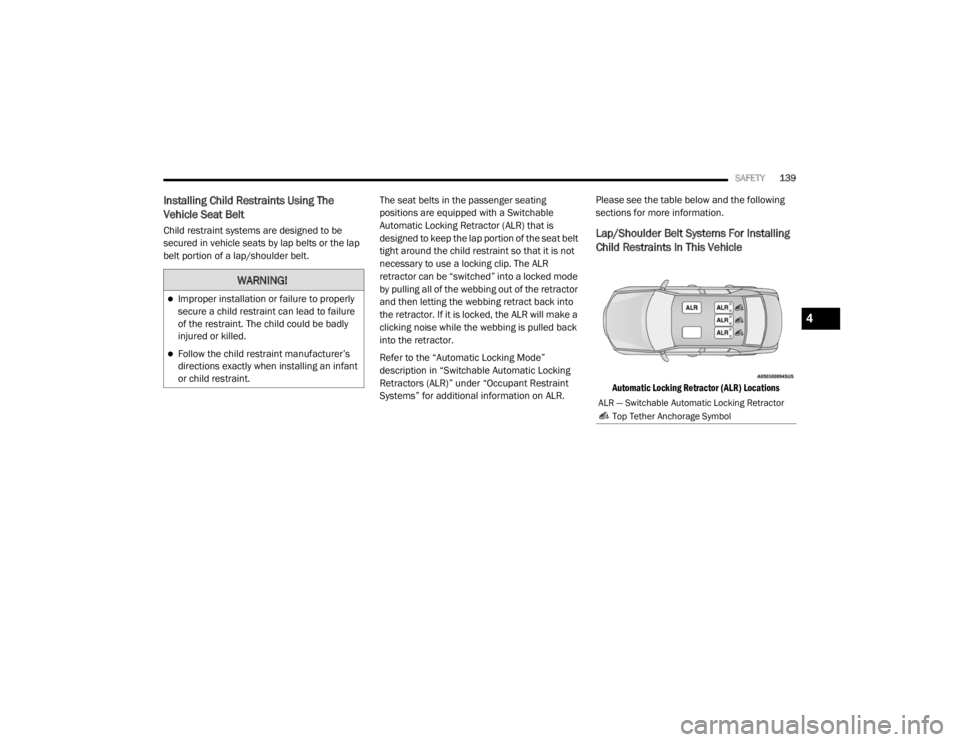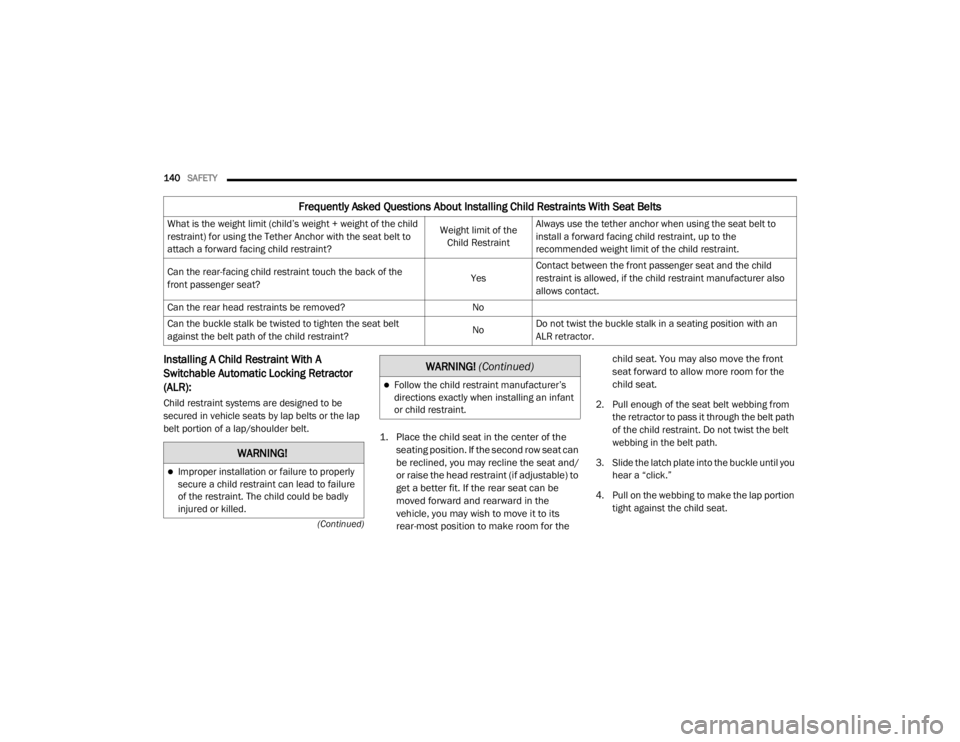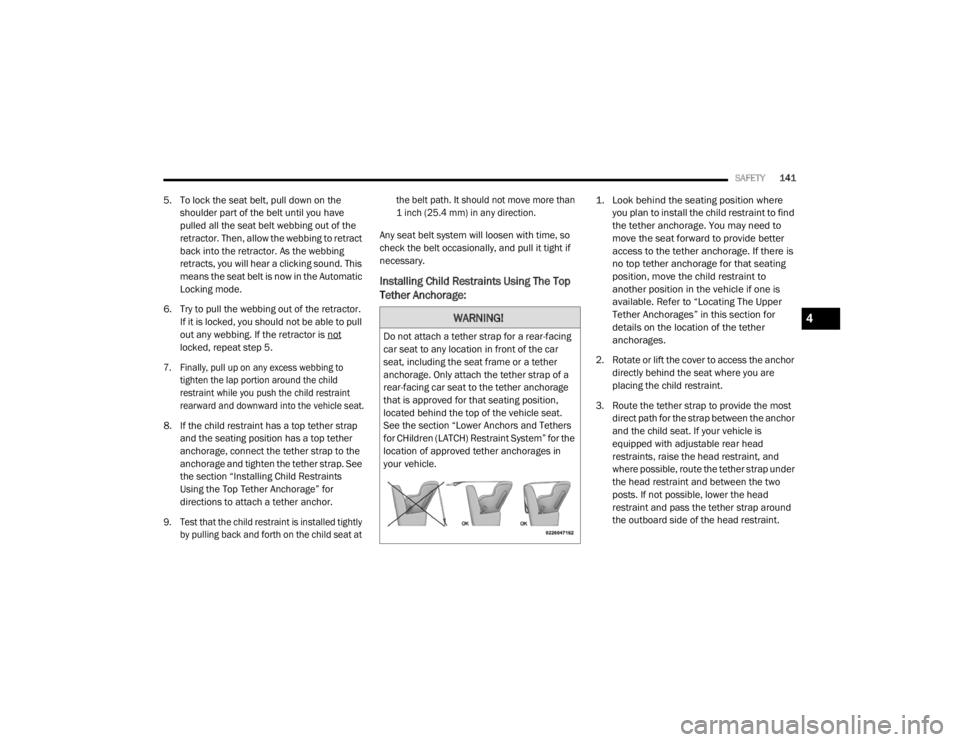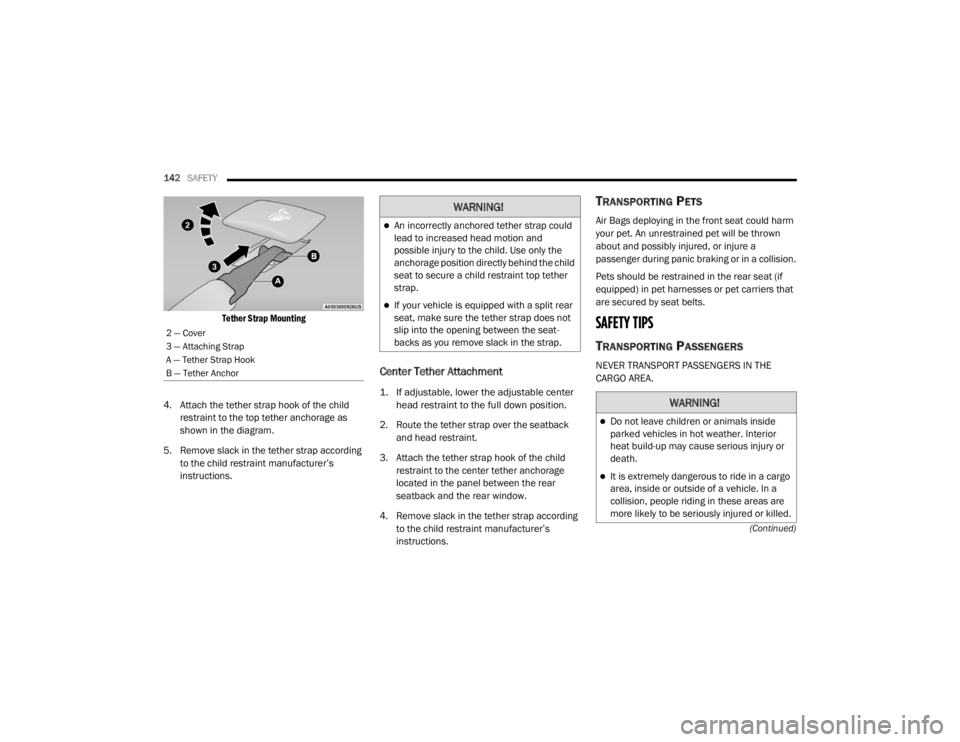2020 CHRYSLER 300 child seat
[x] Cancel search: child seatPage 141 of 328

SAFETY139
Installing Child Restraints Using The
Vehicle Seat Belt
Child restraint systems are designed to be
secured in vehicle seats by lap belts or the lap
belt portion of a lap/shoulder belt. The seat belts in the passenger seating
positions are equipped with a Switchable
Automatic Locking Retractor (ALR) that is
designed to keep the lap portion of the seat belt
tight around the child restraint so that it is not
necessary to use a locking clip. The ALR
retractor can be “switched” into a locked mode
by pulling all of the webbing out of the retractor
and then letting the webbing retract back into
the retractor. If it is locked, the ALR will make a
clicking noise while the webbing is pulled back
into the retractor.
Refer to the “Automatic Locking Mode”
description in “Switchable Automatic Locking
Retractors (ALR)” under “Occupant Restraint
Systems” for additional information on ALR.Please see the table below and the following
sections for more information.Lap/Shoulder Belt Systems For Installing
Child Restraints In This Vehicle
Automatic Locking Retractor (ALR) Locations
WARNING!
Improper installation or failure to properly
secure a child restraint can lead to failure
of the restraint. The child could be badly
injured or killed.
Follow the child restraint manufacturer’s
directions exactly when installing an infant
or child restraint.
ALR — Switchable Automatic Locking Retractor
Top Tether Anchorage Symbol
4
20_LX_OM_EN_USC_t.book Page 139
Page 142 of 328

140SAFETY
(Continued)
Installing A Child Restraint With A
Switchable Automatic Locking Retractor
(ALR):
Child restraint systems are designed to be
secured in vehicle seats by lap belts or the lap
belt portion of a lap/shoulder belt.
1. Place the child seat in the center of the
seating position. If the second row seat can
be reclined, you may recline the seat and/
or raise the head restraint (if adjustable) to
get a better fit. If the rear seat can be
moved forward and rearward in the
vehicle, you may wish to move it to its
rear-most position to make room for the child seat. You may also move the front
seat forward to allow more room for the
child seat.
2. Pull enough of the seat belt webbing from the retractor to pass it through the belt path
of the child restraint. Do not twist the belt
webbing in the belt path.
3. Slide the latch plate into the buckle until you hear a “click.”
4. Pull on the webbing to make the lap portion tight against the child seat.
Frequently Asked Questions About Installing Child Restraints With Seat Belts
What is the weight limit (child’s weight + weight of the child
restraint) for using the Tether Anchor with the seat belt to
attach a forward facing child restraint? Weight limit of the
Child Restraint Always use the tether anchor when using the seat belt to
install a forward facing child restraint, up to the
recommended weight limit of the child restraint.
Can the rear-facing child restraint touch the back of the
front passenger seat? YesContact between the front passenger seat and the child
restraint is allowed, if the child restraint manufacturer also
allows contact.
Can the rear head restraints be removed? No
Can the buckle stalk be twisted to tighten the seat belt
against the belt path of the child restraint? NoDo not twist the buckle stalk in a seating position with an
ALR retractor.
WARNING!
Improper installation or failure to properly
secure a child restraint can lead to failure
of the restraint. The child could be badly
injured or killed.
Follow the child restraint manufacturer’s
directions exactly when installing an infant
or child restraint.
WARNING!
(Continued)
20_LX_OM_EN_USC_t.book Page 140
Page 143 of 328

SAFETY141
5. To lock the seat belt, pull down on the
shoulder part of the belt until you have
pulled all the seat belt webbing out of the
retractor. Then, allow the webbing to retract
back into the retractor. As the webbing
retracts, you will hear a clicking sound. This
means the seat belt is now in the Automatic
Locking mode.
6. Try to pull the webbing out of the retractor. If it is locked, you should not be able to pull
out any webbing. If the retractor is not
locked, repeat step 5.
7. Finally, pull up on any excess webbing to tighten the lap portion around the child
restraint while you push the child restraint
rearward and downward into the vehicle seat.
8. If the child restraint has a top tether strap and the seating position has a top tether
anchorage, connect the tether strap to the
anchorage and tighten the tether strap. See
the section “Installing Child Restraints
Using the Top Tether Anchorage” for
directions to attach a tether anchor.
9. Test that the child restraint is installed tightly by pulling back and forth on the child seat at the belt path. It should not move more than
1 inch (25.4 mm) in any direction.
Any seat belt system will loosen with time, so
check the belt occasionally, and pull it tight if
necessary.
Installing Child Restraints Using The Top
Tether Anchorage:
1. Look behind the seating position where you plan to install the child restraint to find
the tether anchorage. You may need to
move the seat forward to provide better
access to the tether anchorage. If there is
no top tether anchorage for that seating
position, move the child restraint to
another position in the vehicle if one is
available. Refer to “Locating The Upper
Tether Anchorages” in this section for
details on the location of the tether
anchorages.
2. Rotate or lift the cover to access the anchor directly behind the seat where you are
placing the child restraint.
3. Route the tether strap to provide the most direct path for the strap between the anchor
and the child seat. If your vehicle is
equipped with adjustable rear head
restraints, raise the head restraint, and
where possible, route the tether strap under
the head restraint and between the two
posts. If not possible, lower the head
restraint and pass the tether strap around
the outboard side of the head restraint.
WARNING!
Do not attach a tether strap for a rear-facing
car seat to any location in front of the car
seat, including the seat frame or a tether
anchorage. Only attach the tether strap of a
rear-facing car seat to the tether anchorage
that is approved for that seating position,
located behind the top of the vehicle seat.
See the section “Lower Anchors and Tethers
for CHildren (LATCH) Restraint System” for the
location of approved tether anchorages in
your vehicle.
4
20_LX_OM_EN_USC_t.book Page 141
Page 144 of 328

142SAFETY
(Continued)
Tether Strap Mounting
4. Attach the tether strap hook of the child restraint to the top tether anchorage as
shown in the diagram.
5. Remove slack in the tether strap according to the child restraint manufacturer’s
instructions.
Center Tether Attachment
1. If adjustable, lower the adjustable center head restraint to the full down position.
2. Route the tether strap over the seatback and head restraint.
3. Attach the tether strap hook of the child restraint to the center tether anchorage
located in the panel between the rear
seatback and the rear window.
4. Remove slack in the tether strap according to the child restraint manufacturer’s
instructions.
TRANSPORTING PETS
Air Bags deploying in the front seat could harm
your pet. An unrestrained pet will be thrown
about and possibly injured, or injure a
passenger during panic braking or in a collision.
Pets should be restrained in the rear seat (if
equipped) in pet harnesses or pet carriers that
are secured by seat belts.
SAFETY TIPS
TRANSPORTING PASSENGERS
NEVER TRANSPORT PASSENGERS IN THE
CARGO AREA.
2 — Cover
3 — Attaching Strap
A — Tether Strap Hook
B — Tether Anchor
WARNING!
An incorrectly anchored tether strap could
lead to increased head motion and
possible injury to the child. Use only the
anchorage position directly behind the child
seat to secure a child restraint top tether
strap.
If your vehicle is equipped with a split rear
seat, make sure the tether strap does not
slip into the opening between the seat -
backs as you remove slack in the strap.
WARNING!
Do not leave children or animals inside
parked vehicles in hot weather. Interior
heat build-up may cause serious injury or
death.
It is extremely dangerous to ride in a cargo
area, inside or outside of a vehicle. In a
collision, people riding in these areas are
more likely to be seriously injured or killed.
20_LX_OM_EN_USC_t.book Page 142
Page 148 of 328

146 (Continued)
(Continued)
STARTING AND OPERATING
STARTING THE ENGINE
Before starting your vehicle, adjust your seat,
adjust the inside and outside mirrors, fasten
your seat belt, and if present, instruct all other
occupants to buckle their seat belts.
AUTOMATIC TRANSMISSION
The gear selector must be in the PARK position
before you can start the engine. Apply the
brakes before shifting into any driving gear.
KEYLESS ENTER-N-GO — IGNITION
This feature allows the driver to operate the
ignition switch with the push of a button, as long
as the Remote Start/Keyless Enter-N-Go key
fob is in the passenger compartment.
NORMAL STARTING
To Turn On The Engine Using The ENGINE
START/STOP Button
1. The transmission must be in PARK.
2. Press and hold the brake pedal while
pushing the ENGINE START/STOP button
once.
WARNING!
When exiting the vehicle, always make sure
the ignition is in OFF mode, remove the key
fob from the vehicle and lock the vehicle.
Never leave children alone in a vehicle, or
with access to an unlocked vehicle. Leaving
children in a vehicle unattended is
dangerous for a number of reasons. A child
or others could be seriously or fatally
injured. Children should be warned not to
touch the parking brake, brake pedal or the
transmission gear selector.
Do not leave the key fob in or near the
vehicle (or in a location accessible to chil -
dren), and do not leave the ignition (of a
vehicle equipped with Keyless Enter-N-Go)
in the ACC or ON/RUN mode. A child could
operate power windows, other controls, or
move the vehicle.
Do not leave children or animals inside
parked vehicles in hot weather. Interior
heat build-up may cause serious injury or
death.
CAUTION!
Shift into or out of PARK or REVERSE only
after the vehicle has come to a complete
stop.
WARNING! (Continued)
Do not shift between PARK, REVERSE,
NEUTRAL, or DRIVE when the engine is
above idle speed.
Before shifting into any gear, make sure
your foot is firmly pressing the brake pedal.
CAUTION! (Continued)
20_LX_OM_EN_USC_t.book Page 146
Page 318 of 328

316 AWD Towing
....................................................... 229Axle Fluid............................................. 281, 283Axle Lubrication................................... 281, 283
B
Back-Up......................................................... 186Battery.................................................... 86, 238Charging System Light................................. 86Keyless Key Fob Replacement.................... 13Location.................................................... 238Belts, Seat..................................................... 143Beverage Holder Cooled (Cupholder).............. 73Beverage Holder Heated (Cupholder).............. 73Body Mechanism Lubrication........................ 244B-Pillar Location............................................. 257Brake Assist System........................................ 96Brake Control System...................................... 96Brake Fluid................................. 251, 281, 283Brake System...................................... 250, 275Fluid Check............................ 251, 281, 283Master Cylinder......................................... 251Parking...................................................... 150Warning Light..................................... 85, 275Brake/Transmission Interlock....................... 153Break-In Recommendations, New Vehicle..... 150Brightness, Interior Lights................................ 48Bulb Replacement......................................... 206Bulbs, Light.......................................... 145, 206
C
Camera, Rear................................................ 186Capacities, Fluid........................................... 280Caps, FillerOil (Engine)...................................... 236, 241Radiator (Coolant Pressure)..................... 249Car Washes................................................... 272Carbon Monoxide Warning................... 143, 279CargoVehicle Loading........................................ 190Cargo Area Cover............................................. 64Cargo Compartment........................................ 64Cellular Phone.............................................. 303Certification Label......................................... 190Chains, Tire................................................... 269Changing A Flat Tire...................................... 253Chart, Tire Sizing........................................... 254Check Engine Light
(Malfunction Indicator Light)............................ 93Checking Your Vehicle For Safety................. 142Checks, Safety.............................................. 142Child Restraint.............................................. 130Child RestraintsBooster Seats........................................... 133Child Seat Installation.............................. 140How To Stow An unused ALR Seat Belt.... 138Infant And Child Restraints....................... 132Lower Anchors And Tethers For Children.. 135Older Children And Child Restraints......... 132
Seating Positions...................................... 134Child Safety Locks............................................28Clean Air Gasoline......................................... 277CleaningWheels...................................................... 268Climate Control................................................50Automatic....................................................50Coin Holder......................................................71Cold Weather Operation................................ 149Compact Spare Tire...................................... 266ConsoleFloor............................................................71Contract, Service........................................... 312Cooling Pressure Cap (Radiator Cap)............ 249Cooling System............................................. 247Adding Coolant (Antifreeze)...................... 248Coolant Capacity....................................... 280Coolant Level................................... 247, 250Disposal Of Used Coolant......................... 249Drain, Flush, And Refill............................. 248Inspection................................................. 250Points To Remember................................ 250Pressure Cap............................................ 249Radiator Cap............................................. 249Selection Of Coolant (Antifreeze)......................... 248, 280, 281Corrosion Protection..................................... 272Cruise Control (Speed Control)............. 160, 163Cruise Light............................................... 91, 92
20_LX_OM_EN_USC_t.book Page 316
Page 319 of 328

317
Cupholders
...................................................... 72Customer Assistance..................................... 311Cybersecurity................................................. 284
D
Daytime Running Lights................................... 43Dealer Service............................................... 239Deck Lid Power Release............................................ 62Defroster, Windshield.................................... 144Delay (Intermittent) Wipers.............................. 49Diagnostic System, Onboard........................... 93Dimmer SwitchHeadlight..................................................... 43DipsticksOil (Engine)................................................ 238Disable Vehicle Towing.................................. 228DisposalAntifreeze (Engine Coolant)....................... 249Disturb........................................................... 308Door Ajar.......................................................... 86Door Ajar Light................................................. 86Door LocksAutomatic.................................................... 28Child-Protection Door Lock — Rear Doors.... 28Doors............................................................... 23Driver’s Seat Back Tilt..................................... 30DrivingThrough Flowing, Rising, Or Shallow Standing Water
..................................... 199
E
Electric Brake Control System.......................... 96Anti-Lock Brake System............................... 95Electronic Roll Mitigation....................97, 102Electric Remote Mirrors................................... 40Electronic Power Distribution Center
(Fuses).......................................................... 210Electronic Speed Control (Cruise Control)..... 161Electronic Stability Control (ESC)..................... 97Electronic Throttle Control Warning Light......... 86Emergency Gas Can Refueling...................... 224Emergency, In Case OfFreeing Vehicle When Stuck..................... 227Hazard Warning Flasher........................... 201Jacking............................................ 217, 253Jump Starting........................................... 222Towing...................................................... 228Emission Control System Maintenance........... 93Engine.................................................. 236, 237Air Cleaner................................................ 241Block Heater............................................. 149Break-In Recommendations..................... 150Checking Oil Level.................................... 238Compartment.................................. 236, 237Compartment Identification...................... 236Coolant (Antifreeze)......................... 247, 281Cooling..................................................... 247Exhaust Gas Caution....................... 143, 279Fails To Start............................................ 149Flooded, Starting...................................... 149
Fuel Requirements................................... 276Jump Starting........................................... 222Oil...........................................240, 280, 281Oil Filler Cap.................................... 236, 241Oil Filter.................................................... 241Oil Selection..................................... 240, 280Oil Synthetic.............................................. 241Overheating.............................................. 225Starting..................................................... 146Engine Oil Viscosity.............................. 240, 241Engine Oil Viscosity Chart.............................. 240Enhanced Accident Response
Feature................................................ 129, 230Ethanol.......................................................... 277Exhaust Gas Cautions.......................... 143, 279Exhaust System................................... 143, 246Exterior Lighting...............................................42Exterior Lights........................................ 42, 145
F
FiltersAir Cleaner
................................................ 241Air Conditioning................................. 57, 243Engine Oil........................................ 241, 281Engine Oil Disposal................................... 241Flashers........................................................ 201Hazard Warning........................................ 201Turn Signals................................ 46, 92, 145Flash-To-Pass...................................................44Flooded Engine Starting................................ 149
11
20_LX_OM_EN_USC_t.book Page 317
Page 321 of 328

319
J
Jack Location
................................................. 218Jack Operation..................................... 219, 253Jacking Instructions....................................... 219Jump Starting................................................ 222
K
Key Fob Arm The System
.......................................... 22Panic Alarm................................................. 13Programming Additional Key Fobs....... 15, 21Unlatch The Trunk....................................... 13Key Fob Battery Service
(Remote Keyless Entry)................................... 13Key Fob Programming
(Remote Keyless Entry)................................... 15Key-In Reminder.............................................. 17Keyless Enter-N-Go................................. 24, 146Enter The Trunk........................................... 13Passive Entry............................................... 24Passive Entry Programming......................... 24Keys................................................................. 11Replacement........................................ 15, 21
L
Lane Change And Turn Signals........................ 46Lane Change Assist......................................... 46LaneSense.................................................... 183Lap/Shoulder Belts....................................... 115
Latches......................................................... 145Hood............................................................ 61Lead Free Gasoline....................................... 276Leaks, Fluid.................................................. 145Life Of Tires................................................... 264Light Bulbs........................................... 145, 206Lights............................................................ 145Air Bag...................................... 85, 122, 143Automatic Headlights.................................. 44Brake Assist Warning.................................. 99Brake Warning....................................85, 275Bulb Replacement.................................... 206Cruise................................................... 91, 92Daytime Running......................................... 43Dimmer Switch, Headlight.................... 42, 43Engine Temperature Warning...................... 86Exterior..................................................... 145Fog.............................................................. 45Hazard Warning Flasher........................... 201Headlight Switch.......................................... 42Headlights...................................42, 45, 207Headlights On With Wipers.......................... 44High Beam................................................... 43High Beam/Low Beam Select...................... 43Instrument Cluster....................................... 42Intensity Control.......................................... 48Interior......................................................... 46License..................................................... 209Lights On Reminder..................................... 45
Malfunction Indicator (Check Engine)..........88Map.............................................................47Park......................................................44, 92Passing........................................................44Reading.......................................................47Seat Belt Reminder.....................................87Security Alarm.............................................87Service...................................................... 206Traction Control...........................................99Turn Signals......................... 42, 46, 92, 145Vanity Mirror................................................42Warning Instrument ClusterDescriptions.....................................86, 92Load Leveling System......................................65Load Shed Battery Saver On............................83Load Shed Electrical Load Reduction..............83Load Shed Intelligent Battery Sensor...............83Loading Vehicle............................................. 190Capacities................................................. 190Tires.......................................................... 257LocksAuto Unlock.................................................27Automatic Door............................................28Child Protection...........................................28Power Door..................................................24Low Tire Pressure System............................. 109Lubrication, Body.......................................... 244Lug Nuts........................................................ 27511
20_LX_OM_EN_USC_t.book Page 319